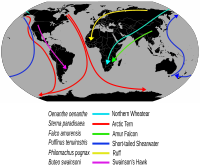
Photo from wikipedia
Phenological mismatch is often cited as a putative driver of population declines in long-distance migratory birds. The mechanisms and cues utilised to advance breeding ground arrival will impact the adaptability… Click to show full abstract
Phenological mismatch is often cited as a putative driver of population declines in long-distance migratory birds. The mechanisms and cues utilised to advance breeding ground arrival will impact the adaptability of species to further warming. Furthermore, timing of post-breeding migration potentially faces diverging selective pressures, with earlier onset of tropical dry seasons favouring migration advancement, whilst longer growing seasons in temperate areas could facilitate delayed departures. Despite this, few studies exist of migration phenology on the non-breeding grounds or on post-breeding passage. Here, we use first-arrival and last-departure dates of 20 species of trans-Saharan migratory birds from tropical non-breeding grounds (The Gambia), between 1964 and 2019. Additionally, we use first-arrival and last-departure dates, as well as median arrival and departure dates, at an entry/departure site to/from Europe (Gibraltar), between 1991 and 2018. We assess phenological trends in pre- and post-breeding migration, as well as individual species' durations of stay in breeding and non-breeding areas. Furthermore, we assess the extent to which inter-annual variation in these timings may be explained by meteorological and ecological variables. We find significant advances in pre-breeding migration at both locations, whilst post-breeding migration is delayed. At Gibraltar, these trends do not differ between first/last and median dates of migration. The combination of these trends suggests substantial changes in the temporal usage of the two continents by migratory birds. Duration of stay (of species, not individuals) within Europe increased by 16 days, on average, over the 27-year monitoring period. By contrast, duration of species' stays on the non-breeding range declined by 63 days, on average, over the 56-year monitoring period. Taken together these changes suggest substantial, previously unreported alterations to annual routines in Afro-Palearctic migrants.
Journal Title: Global change biology
Year Published: 2021
Link to full text (if available)
Share on Social Media: Sign Up to like & get
recommendations!